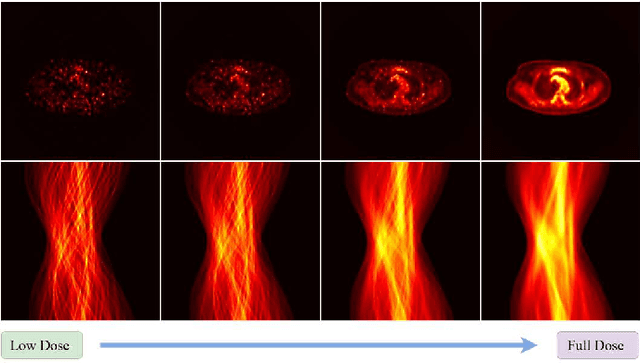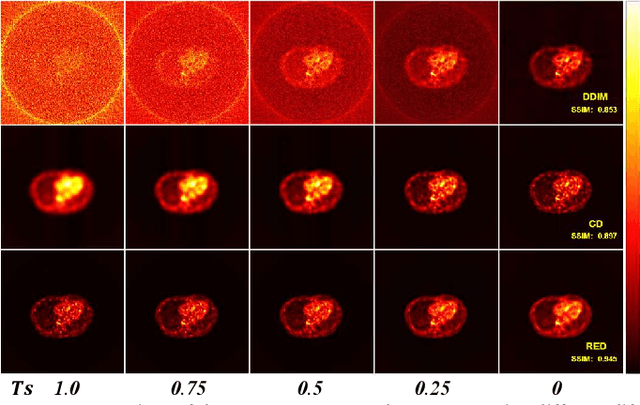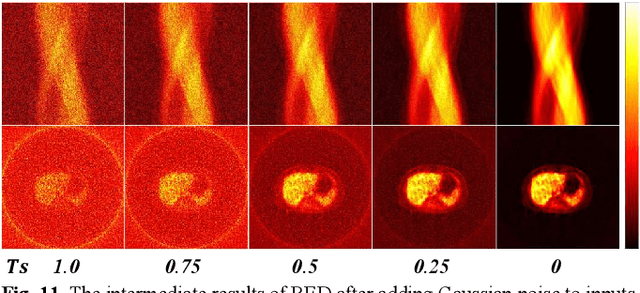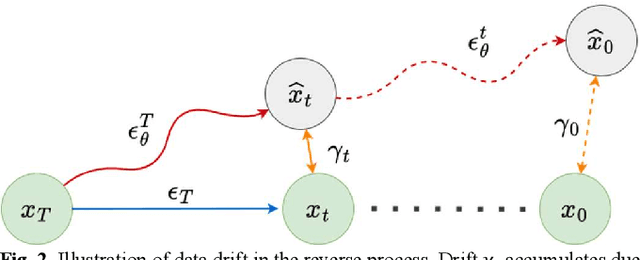Binxuan Li
Diffusion Transformer Meets Random Masks: An Advanced PET Reconstruction Framework
Mar 11, 2025Abstract:Deep learning has significantly advanced PET image re-construction, achieving remarkable improvements in image quality through direct training on sinogram or image data. Traditional methods often utilize masks for inpainting tasks, but their incorporation into PET reconstruction frameworks introduces transformative potential. In this study, we pro-pose an advanced PET reconstruction framework called Diffusion tRansformer mEets rAndom Masks (DREAM). To the best of our knowledge, this is the first work to integrate mask mechanisms into both the sinogram domain and the latent space, pioneering their role in PET reconstruction and demonstrating their ability to enhance reconstruction fidelity and efficiency. The framework employs a high-dimensional stacking approach, transforming masked data from two to three dimensions to expand the solution space and enable the model to capture richer spatial rela-tionships. Additionally, a mask-driven latent space is de-signed to accelerate the diffusion process by leveraging sinogram-driven and mask-driven compact priors, which reduce computational complexity while preserving essen-tial data characteristics. A hierarchical masking strategy is also introduced, guiding the model from focusing on fi-ne-grained local details in the early stages to capturing broader global patterns over time. This progressive ap-proach ensures a balance between detailed feature preservation and comprehensive context understanding. Experimental results demonstrate that DREAM not only improves the overall quality of reconstructed PET images but also preserves critical clinical details, highlighting its potential to advance PET imaging technology. By inte-grating compact priors and hierarchical masking, DREAM offers a promising and efficient avenue for future research and application in PET imaging. The open-source code is available at: https://github.com/yqx7150/DREAM.
RED: Residual Estimation Diffusion for Low-Dose PET Sinogram Reconstruction
Nov 08, 2024



Abstract:Recent advances in diffusion models have demonstrated exceptional performance in generative tasks across vari-ous fields. In positron emission tomography (PET), the reduction in tracer dose leads to information loss in sino-grams. Using diffusion models to reconstruct missing in-formation can improve imaging quality. Traditional diffu-sion models effectively use Gaussian noise for image re-constructions. However, in low-dose PET reconstruction, Gaussian noise can worsen the already sparse data by introducing artifacts and inconsistencies. To address this issue, we propose a diffusion model named residual esti-mation diffusion (RED). From the perspective of diffusion mechanism, RED uses the residual between sinograms to replace Gaussian noise in diffusion process, respectively sets the low-dose and full-dose sinograms as the starting point and endpoint of reconstruction. This mechanism helps preserve the original information in the low-dose sinogram, thereby enhancing reconstruction reliability. From the perspective of data consistency, RED introduces a drift correction strategy to reduce accumulated prediction errors during the reverse process. Calibrating the inter-mediate results of reverse iterations helps maintain the data consistency and enhances the stability of reconstruc-tion process. Experimental results show that RED effec-tively improves the quality of low-dose sinograms as well as the reconstruction results. The code is available at: https://github.com/yqx7150/RED.
 Add to Chrome
Add to Chrome Add to Firefox
Add to Firefox Add to Edge
Add to Edge